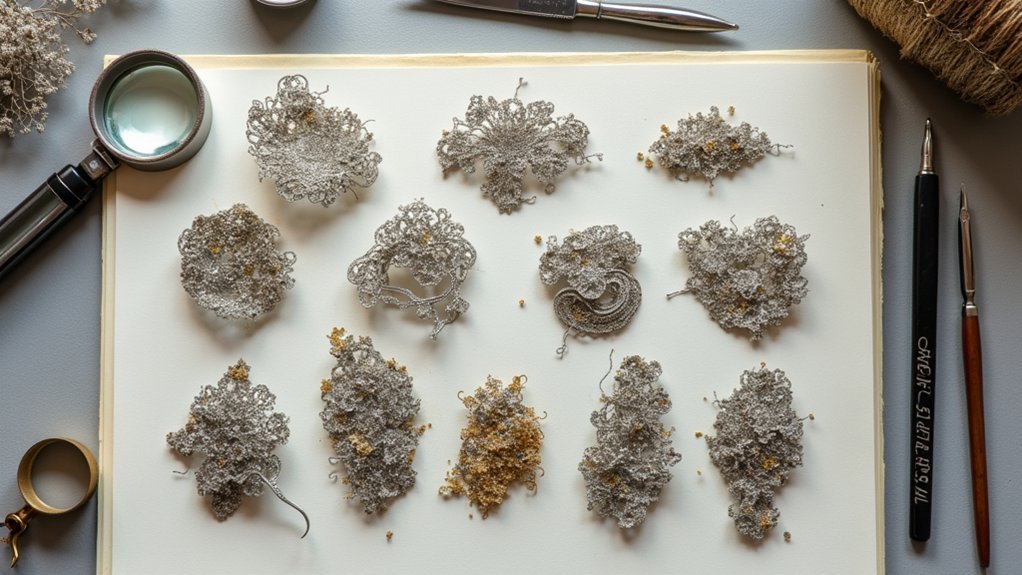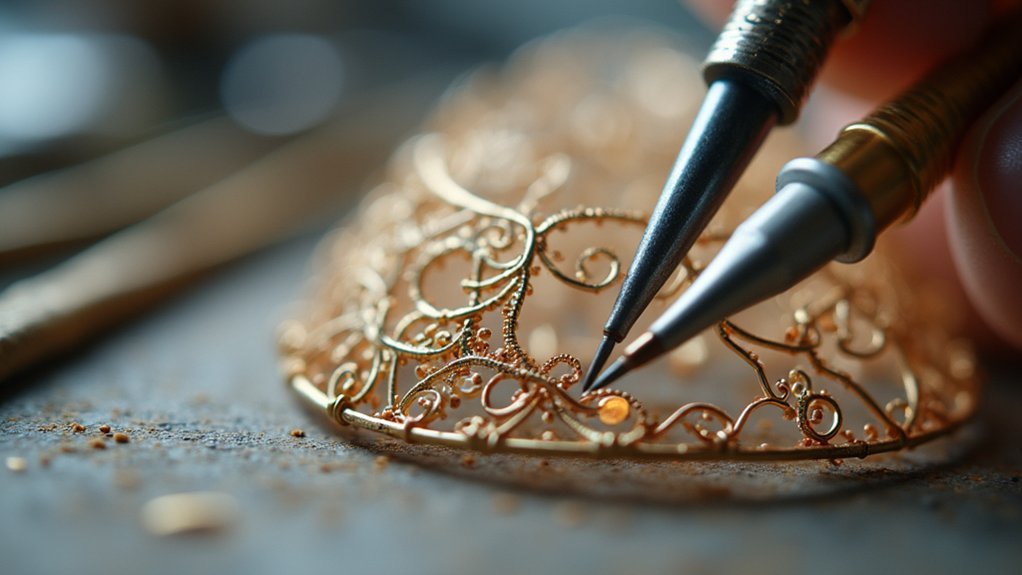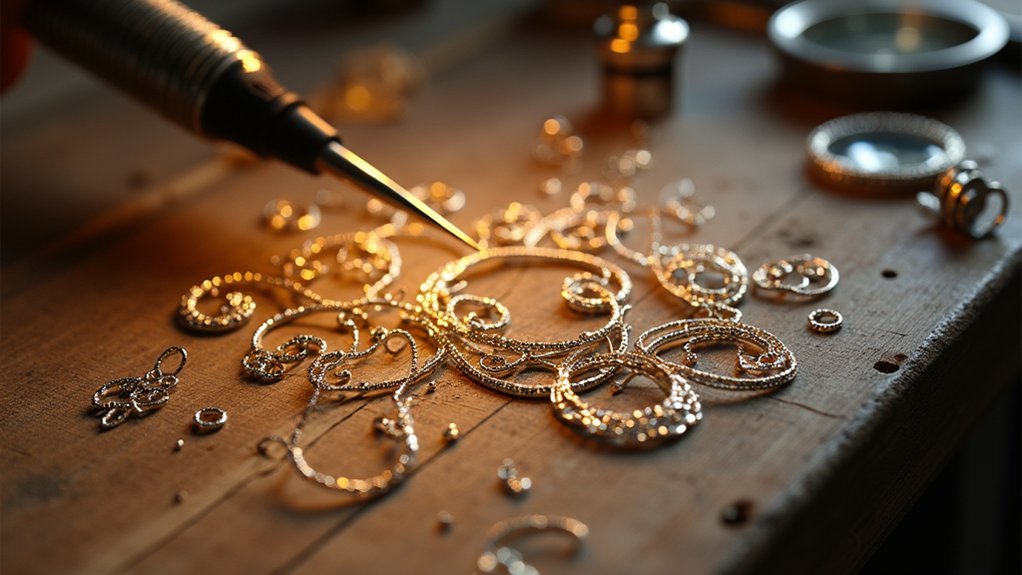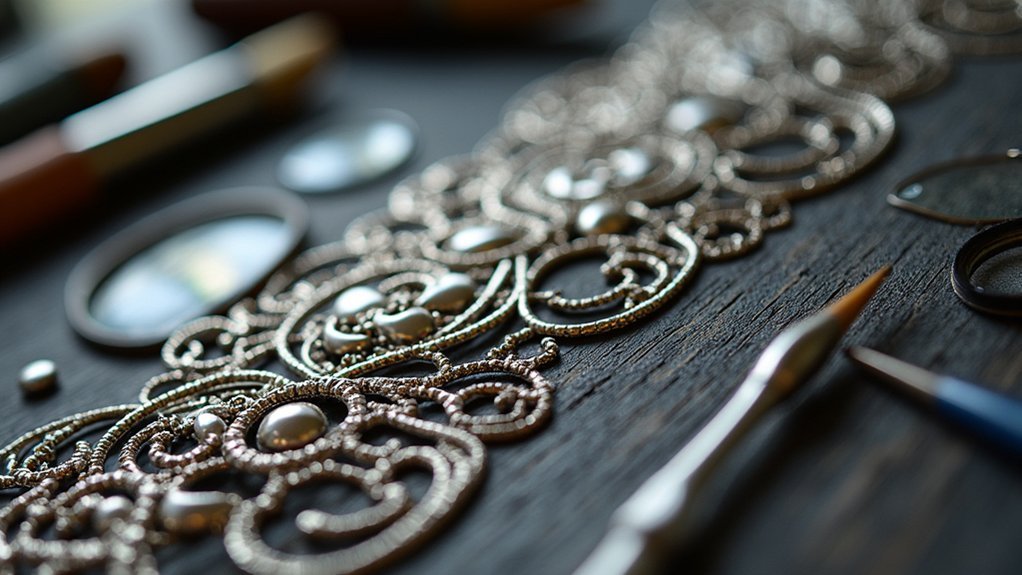You’ll need to master five critical restoration methods to successfully repair delicate filigree jewelry: thorough damage assessment and documentation, gentle cleaning techniques for oxidized surfaces, precision micro-soldering for broken components, traditional wire-drawing skills for recreating missing elements, and protective finishing methods. Start by photographing damage and testing metal composition, then use appropriate cleaning solutions like sodium bicarbonate for silver or mild detergent for gold. The following techniques will transform your restoration approach completely.
Assessing Damage and Documentation Before Restoration

Before beginning any restoration work, you’ll need to conduct a thorough evaluation of your filigree piece to identify specific damage like loose wires, tarnishing, or broken elements.
Document the original condition through detailed photographs and written notes, creating a clear record for future reference and post-restoration comparison.
You’ll want to gauge the piece’s authenticity and historical significance, as this directly influences which restoration methods you’ll use.
Catalog any previous repairs or alterations to understand the jewelry’s history and preserve its integrity.
Consider consulting a professional appraiser or conservator who can verify damage extent and recommend appropriate restoration methods.
This careful documentation and evaluation of damage process guarantees you’ll respect the craftsmanship and heritage of your filigree piece.
Cleaning Delicate Filigree Structures Safely
You’ll need to select the right gentle cleaning solutions based on your filigree’s metal composition—warm water with mild detergent for silver, or dishwashing detergent for gold pieces.
Start by using a small soft brush to carefully remove dust and debris from intricate areas without scratching the metalwork.
Focus on protecting individual wires during cleaning by supporting surrounding structures and working methodically through each section.
Gentle Cleaning Solutions
When working with delicate filigree pieces, proper cleaning techniques make the difference between preservation and permanent damage.
You’ll need gentle cleaning solutions that won’t compromise your filigree pieces’ delicate appearance. Start by mixing warm water with mild detergent, creating a solution gentle enough to prevent tarnishing or scratching the intricate metalwork.
Soak your piece carefully in this mixture, allowing the solution to penetrate and loosen accumulated debris.
After soaking, rinse thoroughly with clean, lukewarm water to eliminate any soap residue that could leave an unwanted film.
Never use abrasive materials or harsh chemicals, as these can destroy the fine metal wires and detailed patterns.
When drying, gently blot with a soft cloth rather than rubbing to avoid scratching the delicate surfaces.
Wire Protection Techniques
Since filigree’s intricate wire structures demand specialized attention, you must adopt precise protection techniques that safeguard each delicate thread during cleaning. Use a soft toothbrush or small, soft-bristled brush to gently remove dust without bending the wires. These wire protection techniques prevent damage to delicate metal threads while maintaining the piece’s integrity.
| Protection Method | Tool Required | Key Benefit |
|---|---|---|
| Gentle brushing | Soft brush | Removes debris safely |
| Controlled pressure | Light touch | Prevents wire bending |
| Proper support | Stable surface | Minimizes stress points |
Avoid harsh chemicals and abrasive materials that scratch or tarnish the metal. When using your soft brush, work systematically around each wire section, ensuring you don’t pull or stress the connections between threads.
Repairing Broken Wire Components Through Micro-Soldering

Although broken wire components in filigree jewelry might seem irreparable, micro-soldering offers a precise restoration technique that can seamlessly reattach delicate metal threads.
Micro-soldering provides expert jewelers with an invaluable method for restoring seemingly irreparable filigree wire components through precise, delicate reattachment techniques.
You’ll need a fine-tipped soldering iron that operates at very low temperatures to prevent damage to surrounding intricate patterns. When practicing filigree techniques, use a microscope or magnifying tools to accurately position tiny wire components for clean repairs.
Your solder choice is critical—select low-temperature options to avoid melting or altering the filigree metal’s characteristics.
You’ll need steady hands and considerable skill for successful repairs, as micro-soldering requires extreme precision. This specialized method should only be attempted by experienced jewelers familiar with delicate metal threads and traditional filigree restoration practices.
Recreating Missing Elements Using Traditional Techniques
When you’re facing missing sections in antique filigree, you’ll need to master wire drawing reconstruction methods that match the original craftsman’s techniques.
You can’t simply substitute modern wires—instead, you must draw fine metal wires between 0.25mm and 0.4mm diameters to guarantee seamless integration with existing elements.
Your success depends on combining these traditional wire-making skills with precise soldering of historical patterns that preserve the piece’s authentic character.
Wire Drawing Reconstruction Methods
As you begin reconstructing missing filigree elements, wire drawing becomes your primary method for creating the delicate components that match the original craftsmanship. This traditional technique requires reducing metal rods to create wires measuring 0.25mm to 0.4mm in diameter. You’ll need to anneal frequently during the process to maintain malleability and prevent brittleness.
| Wire Drawing Process | Key Requirements |
|---|---|
| Initial rod preparation | Select appropriate metal gauge |
| Drawing progression | Gradual diameter reduction |
| Annealing frequency | Every 2-3 passes |
| Final wire diameter | 0.25mm to 0.4mm |
| Quality assessment | Check for consistent thickness |
Once you’ve created the wires, you’ll shape and twist them into intricate designs that closely match original patterns. Soldering at contact points using progressively lower melting point solders guarantees secure attachment while maintaining the piece’s structural integrity throughout your filigree restoration project.
Soldering Historical Pattern Techniques
Since successful filigree restoration depends on your ability to seamlessly integrate new elements with existing metalwork, you’ll need to master the progressive soldering technique that uses multiple solder types with decreasing melting points. This approach prevents heat damage to previously joined areas while guaranteeing strong bonds throughout the piece.
You’ll begin by carefully aligning filigree components to match the original design patterns precisely.
Traditional soldering methods require you to apply flux strategically, then heat the joint until solder flows smoothly without overflow. Your precision in controlling temperature and solder placement directly impacts the restoration’s authenticity.
Regular practice with historical patterns keeps your soldering techniques sharp and maintains professional standards.
This ongoing training guarantees you can recreate missing elements that perfectly match the original craftsman’s work.
Strengthening Weakened Joints and Connections

Although filigree’s intricate wirework creates stunning visual appeal, the delicate joints connecting these fine metal threads represent the most vulnerable points in any antique piece.
You’ll need to carefully apply solder at contact points, using progressively lower melting points to protect the delicate metalwork during repair work. Artisans skill becomes essential when working under a microscope to achieve precise alignment and maintain design integrity.
You should inspect solder joints every 12-18 months for wear or loosening. For additional reinforcement, weave fine wire through break-prone areas to create stability while preserving aesthetics.
Always clean thoroughly before beginning soldering, as residues will hinder effectiveness and weaken restoration bonds. This systematic approach guarantees long-lasting repairs.
Restoring Oxidized and Tarnished Metal Surfaces
The delicate metal surfaces of filigree pieces inevitably develop oxidation and tarnish over time, creating dull spots that mask the jewelry’s inherent brilliance.
Time and exposure cause filigree jewelry’s intricate metal surfaces to lose their original shine through natural oxidation processes.
You’ll need gentle restoration techniques to revive your filigree jewelry without damaging intricate patterns.
Create a cleaning solution using warm water and mild detergent to remove surface grime effectively. For silver pieces, soak them in sodium bicarbonate mixed with water to eliminate oxidation naturally. Gold filigree responds well to warm water combined with dishwashing detergent—just guarantee thorough rinsing afterward.
Always avoid abrasive materials and harsh chemicals that can scratch delicate designs. After cleaning, dry your pieces completely with a soft cloth to prevent water spots.
Regular maintenance through gentle brushing with lint-free cloths prevents future tarnish buildup and preserves your jewelry’s original luster.
Reassembling Complex Multi-Component Pieces

When working with complex multi-component filigree pieces, you’ll face the intricate challenge of reconstructing delicate elements that may have separated or become damaged over time.
Start your restoration by meticulously documenting each component’s original placement and orientation to preserve the design’s integrity.
Use specialized tools like tweezers and magnifying glasses when handling these delicate pieces to prevent additional damage.
Apply clear adhesive as a temporary measure to hold components in place during initial reassembling stages.
When you’re ready for permanent attachment, employ low-temperature soldering techniques to avoid melting or warping the intricate elements while ensuring strong bonds.
Throughout the restoration process, conduct regular inspections to identify misalignments or structural weaknesses, allowing you to make timely adjustments before finalizing your work.
Final Polishing and Protective Finishing Methods
After completing the reassembly of your filigree piece, focus shifts to achieving a pristine finish that showcases the intricate craftsmanship while protecting the restored work.
For final polishing, use a soft cloth or polishing wheel to enhance shine and highlight intricate patterns without damaging delicate elements. Avoid abrasive materials and harsh chemicals that’ll compromise the fine details.
Implement protective finishing by applying a thin layer of wax or lacquer to shield against tarnishing and environmental damage.
Ultrasonic cleaners effectively remove dirt and grime, but exercise caution to prevent loosening delicate components.
Conduct regular inspection throughout the polishing process to identify loose wires or structural weaknesses, enabling timely repairs that maintain your piece’s integrity and preserve its restored beauty.
Frequently Asked Questions
Which of the Following Is an Essential Step in Filigree Workmanship?
You’ll find wire drawing is essential in filigree workmanship, where you reduce metal wire diameter from 1mm to 0.25mm. This creates the delicate threads you’ll need for intricate designs.
What Is Filigree Technique?
You’ll create intricate lace-like jewelry patterns by twisting and soldering hair-thin metal wires, typically gold or silver, measuring 0.25mm to 0.4mm in diameter, resulting in delicate transparent designs.
What Are the Different Styles of Filigree?
You’ll find two main filigree styles: application filigree, where you apply delicate threads onto solid bases for decoration, and integration filigree, where you construct entire pieces from intricate metal threads.
How Do You Clean Filigree Jewelry?
You’ll gently dust filigree jewelry with a soft, lint-free cloth. For deeper cleaning, soak pieces in warm, soapy water, then brush lightly. Avoid harsh chemicals that’ll damage delicate wires.
In Summary
You’ve now mastered the essential techniques for restoring delicate filigree pieces. By carefully documenting damage, cleaning safely, micro-soldering broken wires, and recreating missing elements, you’ll preserve these intricate artworks. Don’t forget to strengthen weak joints, restore tarnished surfaces, and reassemble components methodically. Your final polishing and protective finishing will guarantee these precious pieces maintain their beauty for generations. With practice, you’ll develop the steady hand and patience required for successful filigree restoration.





Leave a Reply